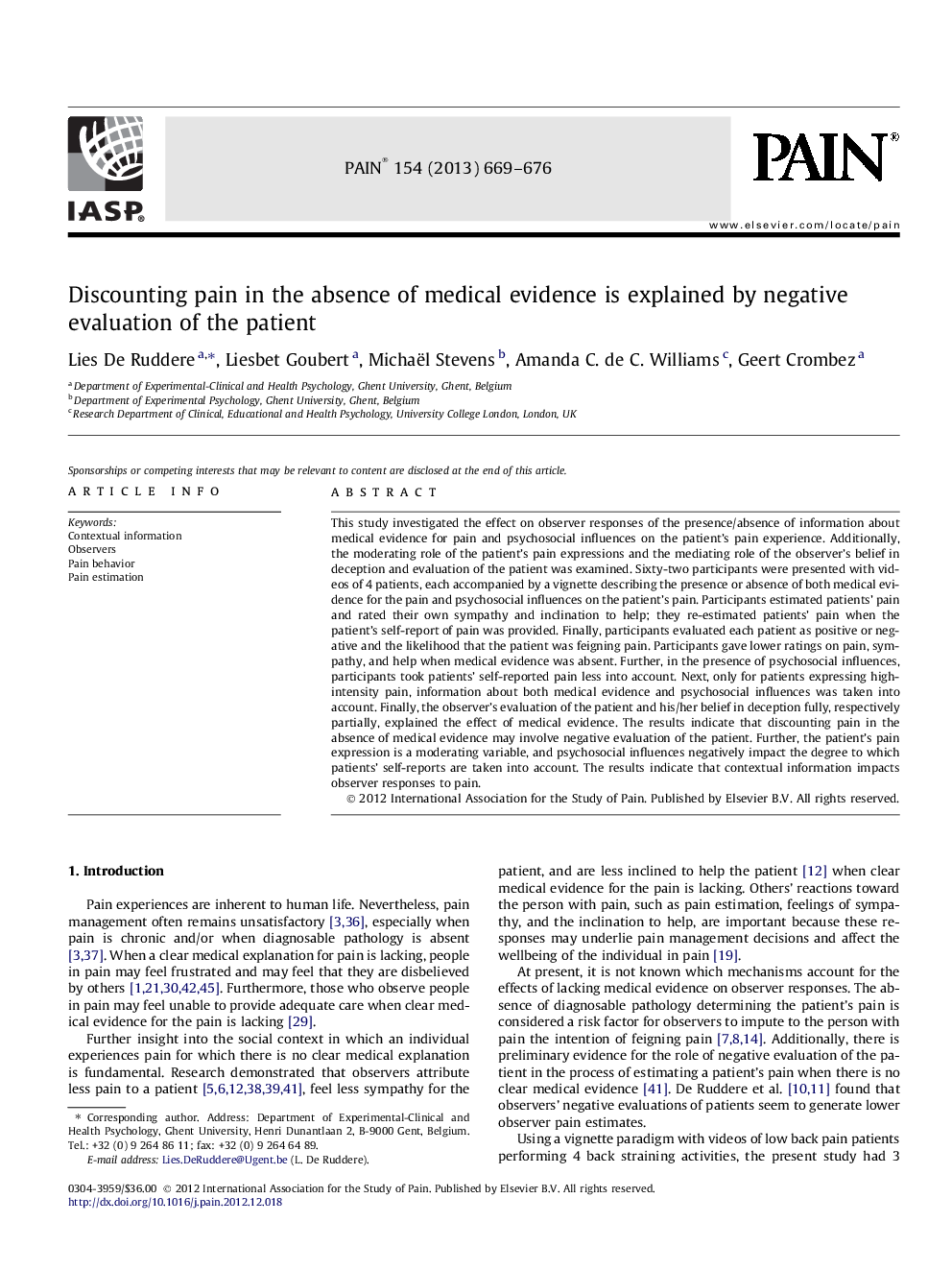| کد مقاله | کد نشریه | سال انتشار | مقاله انگلیسی | نسخه تمام متن |
|---|---|---|---|---|
| 10450646 | 918365 | 2013 | 8 صفحه PDF | دانلود رایگان |
عنوان انگلیسی مقاله ISI
Discounting pain in the absence of medical evidence is explained by negative evaluation of the patient
ترجمه فارسی عنوان
در صورت عدم وجود شواهد پزشکی، کاهش درد با ارزیابی منفی بیمار توضیح داده می شود
دانلود مقاله + سفارش ترجمه
دانلود مقاله ISI انگلیسی
رایگان برای ایرانیان
کلمات کلیدی
اطلاعات متنی، ناظران، رفتار درد، برآورد درد،
ترجمه چکیده
این مطالعه به بررسی تأثیر پاسخ های ناظر بر حضور / عدم وجود اطلاعات در مورد شواهد پزشکی در مورد درد و تاثیرات روانی-اجتماعی بر تجربه درد بیمار پرداخته است. علاوه بر این، نقش مؤثر عالمت درد بیمار و نقش میانجی از اعتقاد ناظر به فریب و ارزیابی بیمار مورد بررسی قرار گرفت. شصت و دو نفر از آنها با فیلم هایی از 4 بیمار ارائه شده که هر یک همراه با یک ضرب المثل وجود دارد که نشان دهنده وجود یا عدم وجود هر دو شواهد پزشکی برای درد و تاثیرات روانی و اجتماعی بر درد بیمار است. شرکت کنندگان درد بیماران را برآورد کردند و همدردی و تمایل خود را برای کمک به آنها ارزیابی کردند. آنها درد بیماران را دوباره ارزیابی می کردند زمانی که خود گزارش خود درد بیمار ارائه می شد. در نهایت، شرکت کنندگان هر بیمار را به عنوان مثبت یا منفی ارزیابی کردند و احتمال این که بیمار درد را تحریک کند. شرکتکنندگان امتیازات کمتری نسبت به درد، همدردی و کمک در هنگام عدم وجود مدارک پزشکی دارند. علاوه بر این، در حضور تأثیرات روانشناختی، شرکت کنندگان بیماران خود را کم کم در نظر گرفتند. بعد، فقط برای بیماران بیان شدت درد شدید، اطلاعات در مورد هر دو شواهد پزشکی و تأثیرات روانی-اجتماعی مورد توجه قرار گرفت. در نهایت ارزیابی ناظر بیمار و اعتقاد به فریب به طور کامل، به طور جزئی، اثر شواهد پزشکی را توضیح داد. نتایج نشان می دهد که عدم تناسب درد در غیاب شواهد پزشکی ممکن است شامل ارزیابی منفی بیمار باشد. علاوه بر این، بیان درد بیمار یک متغیر متغیر است و تأثیرات روانشناختی منفی بر میزان گزارش خود گزارش شده بیمار تاثیر می گذارد. نتایج نشان می دهد که اطلاعات متنی بر پاسخ های ناظر به درد تاثیر می گذارد.
موضوعات مرتبط
علوم زیستی و بیوفناوری
علم عصب شناسی
علوم اعصاب سلولی و مولکولی
چکیده انگلیسی
This study investigated the effect on observer responses of the presence/absence of information about medical evidence for pain and psychosocial influences on the patient's pain experience. Additionally, the moderating role of the patient's pain expressions and the mediating role of the observer's belief in deception and evaluation of the patient was examined. Sixty-two participants were presented with videos of 4 patients, each accompanied by a vignette describing the presence or absence of both medical evidence for the pain and psychosocial influences on the patient's pain. Participants estimated patients' pain and rated their own sympathy and inclination to help; they re-estimated patients' pain when the patient's self-report of pain was provided. Finally, participants evaluated each patient as positive or negative and the likelihood that the patient was feigning pain. Participants gave lower ratings on pain, sympathy, and help when medical evidence was absent. Further, in the presence of psychosocial influences, participants took patients' self-reported pain less into account. Next, only for patients expressing high-intensity pain, information about both medical evidence and psychosocial influences was taken into account. Finally, the observer's evaluation of the patient and his/her belief in deception fully, respectively partially, explained the effect of medical evidence. The results indicate that discounting pain in the absence of medical evidence may involve negative evaluation of the patient. Further, the patient's pain expression is a moderating variable, and psychosocial influences negatively impact the degree to which patients' self-reports are taken into account. The results indicate that contextual information impacts observer responses to pain.
ناشر
Database: Elsevier - ScienceDirect (ساینس دایرکت)
Journal: PAIN® - Volume 154, Issue 5, May 2013, Pages 669-676
Journal: PAIN® - Volume 154, Issue 5, May 2013, Pages 669-676
نویسندگان
Lies De Ruddere, Liesbet Goubert, Michaël Stevens, Amanda C. de C. Williams, Geert Crombez,
